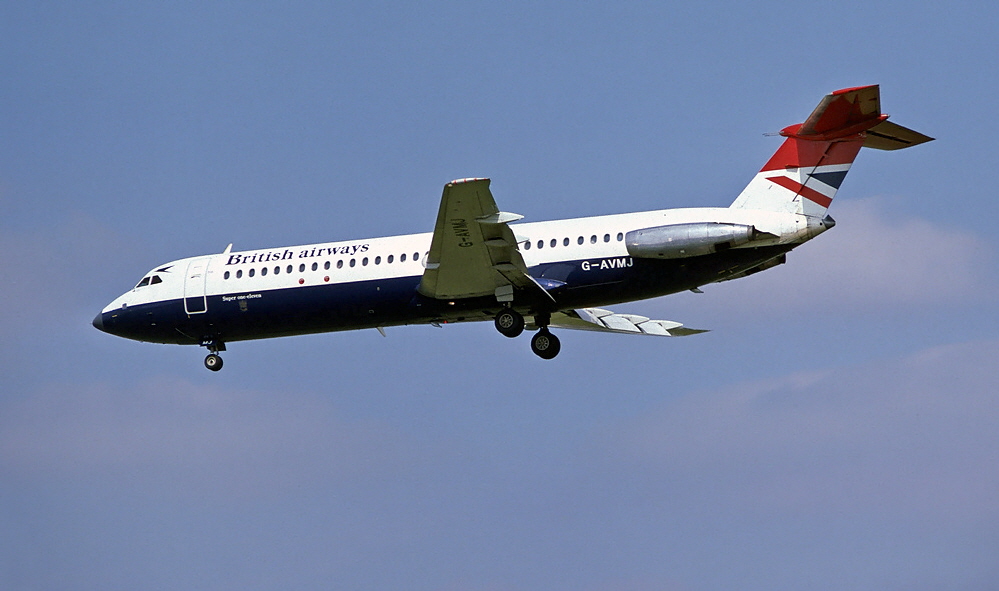 The British Aircraft Corporation One-Eleven, also known as the BAC 1-11 (and informally, The Pocket Rocket), was a short range jet airliner of the 1960s and 1970s. Conceived by Hunting Aircraft, it was developed and produced by the British Aircraft Corporation when Hunting merged into BAC along with other British aircraft makers in 1960.
The British Aircraft Corporation One-Eleven, also known as the BAC 1-11 (and informally, The Pocket Rocket), was a short range jet airliner of the 1960s and 1970s. Conceived by Hunting Aircraft, it was developed and produced by the British Aircraft Corporation when Hunting merged into BAC along with other British aircraft makers in 1960.
The One-Eleven was designed to replace the Vickers Viscount on short-range routes. Following the French Sud Aviation Caravelle, it was the second short-haul jet airliner to enter service. This gave it the advantage of more efficient engines and previous jet-airliner experiences, making it a popular model; over half its sales at launch were to the largest and most lucrative market, the United States. The One-Eleven made it to market ahead of rivals such as the McDonnell Douglas DC-9, which gave it a temporary edge on the market. The One-Eleven was one of the most successful British airliner designs, selling 244 aircraft world-wide, and served until its widespread retirement in the 1990s due to noise restrictions.
Several British operators, including Dan Air and British Caledonian, made extensive use of the type. Dan Air progressively increased the number of One-Elevens they had in service in the 1970s, eventually replacing their ageing first-generation de Havilland Comets with the One-Eleven entirely in the 1980s, with the type becoming the airline's main revenue generator. Dan Air would often lease One-Elevens to meet short-term demands; during periods of low demand Dan Air would also lease its own One-Elevens out to other operators; British Caledonian and Dan Air One-Elevens would often be exchanged between the two airlines on temporary and permanent arrangements. Passenger demand grew on several key One-Eleven routes, exceeding even the BAC 1-11 Series 500 aircraft’s larger capacity during the 1980s, which began to force airlines to use other planes. British Caledonian had begun replacing their One-Elevens with the new Airbus A320, when they were merged with British Airways in 1988 . In both Caledonian and British Airways service, the One-Elevens were a dominant type for the operator's European routes.
Prior to the formation of British Airways (BA), some of its predecessor companies, British European Airways and Cambrian Airways, had been operating the 1-11. British European Airways / British Airways 500 series aircraft varied significantly from other 1-11s, at the request of BEA. Their aircraft had a modified cockpit which incorporated instrumentation and avionics from or similar to that of the Hawker Siddeley Trident, for better commonality with the type. Their additional equipment included a more sophisticated autoflight system, which allowed autolandings and included an autothrottle. The modifications went as far as reversing the "on" position of most switches to match that of the Trident; indeed, this version of the 1-11 was so different from other 1-11 series aircraft that a different type rating was required to fly it. Their fleets would be inherited by BA; British Airways Regional Division found the performance of the One-Eleven more than adequate and sought to expand the airline's operations with the type, including further acquisitions, in the early 1970s in part to replace remaining Vickers Viscounts. BA's 400-Series One-Elevens all received names after areas and locations in the English Midlands, reflecting the type's new base at Birmingham Airport. BA ordered more Series-500 aircraft in the late 1970s and the airline received some of the last British-made One-Elevens.

